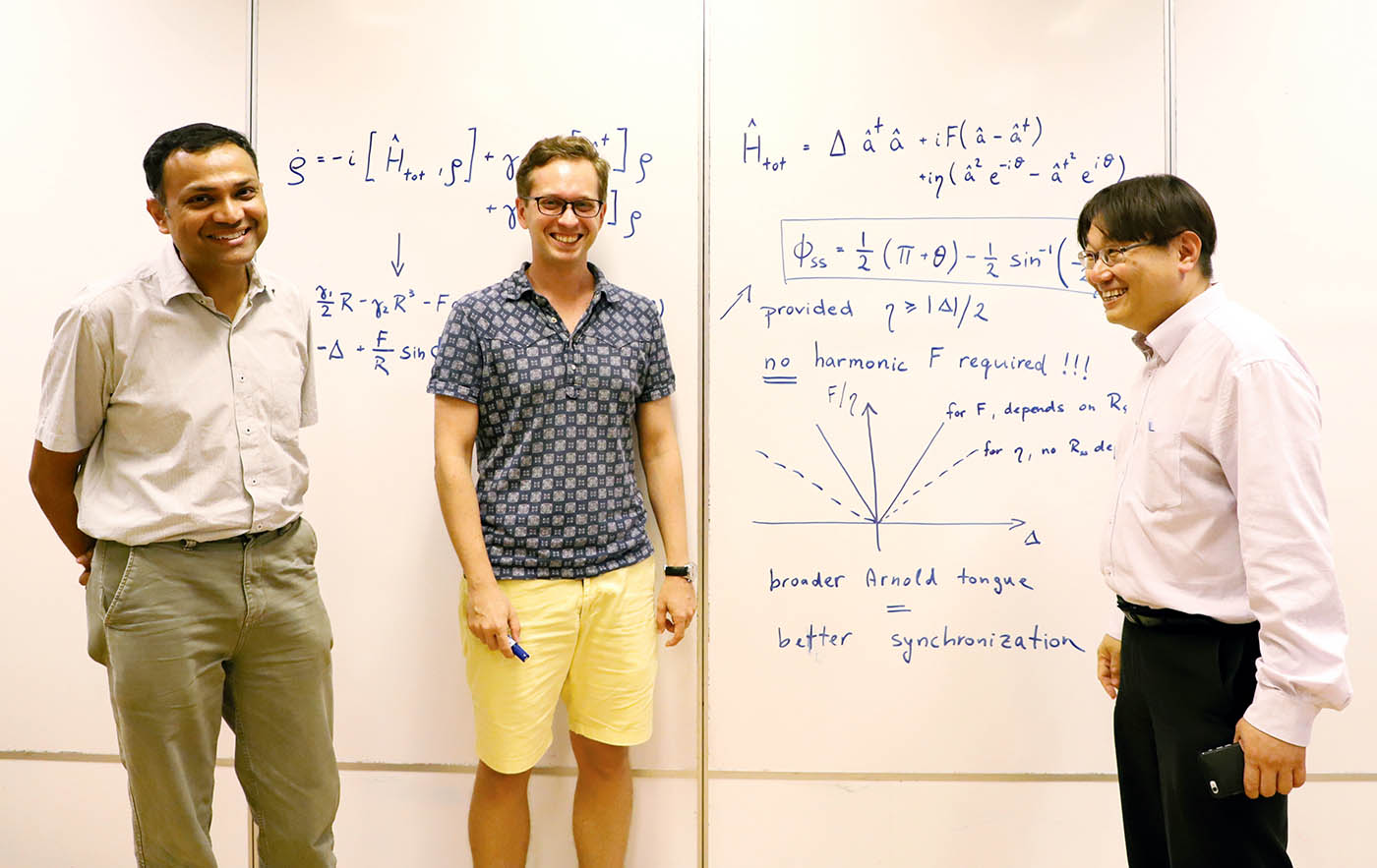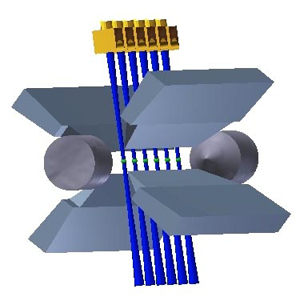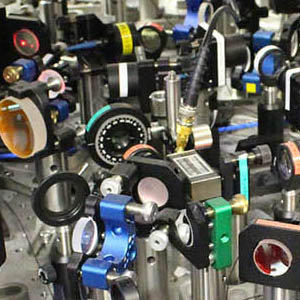Highlights
Squeezing helps quantum particles get in sync
 CQT’s Manas Mukherjee, Michal Hajdusek and Kwek Leong Chuan (named from left to right) are part of a team working out how to get quantum systems to oscillate in sync. They published a novel proposal to enhance the effect in the 20 April issue of Physical Review Letters.
CQT’s Manas Mukherjee, Michal Hajdusek and Kwek Leong Chuan (named from left to right) are part of a team working out how to get quantum systems to oscillate in sync. They published a novel proposal to enhance the effect in the 20 April issue of Physical Review Letters.
A phenomenon that shows up in systems from the beating cells of your heart to the orbital periods of planets can persist into the quantum regime, CQT researchers and their collaborators have calculated.
In a paper highlighted as an Editors' Suggestion in Physical Review Letters, the researchers predict that particles operating under quantum influence can still show synchronization. This refers to the tendency of oscillating systems to sync with each other or with an external driving frequency.
“The area of quantum sync is very new so one can only speculate what real applications it will have in the future. However, seeing the impact classical sync has had on the world and knowing that similar tools are available in the quantum regime is rather exciting,” says CQT’s Michal Hajdusek.
Uncertain trade-off
Physicists had previously feared that noise at the quantum level would wash out synchronization effects. Noise in position or momentum is an intrinsic feature of quantum systems, as famously expressed in Heisenberg’s Uncertainty Principle.
CQT’s Michal Hajdusek, Manas Mukherjee, Rosario Fazio, Vlatko Vedral, Sai Vinjanampathy and Kwek Leong Chuan and collaborator Sameer Sonar at the Indian Institute of Technology-Bombay, have found a way to get around this problem. They show that the sync signature in quantum systems such as trapped ions or miniature cantilevers is boosted if the external drive not only sets a frequency but also ‘squeezes’ the state.
Squeezing is a quantum mechanical effect where uncertainty in one property of a system can be decreased at the expense of increasing the uncertainty in another. Heisenberg’s Uncertainty Principle allows this.
In the proposed system, the trade-off is between uncertainty in the phase of the oscillation and in its strength. The squeezing reduces the noise in the phase – forcing the system to lock onto the external drive and follow its rhythm – while increasing the fluctuations in average number of excitations.
Ions or cantilevers in the quantum regime will naturally vibrate at a certain frequency, which may be excited by shining light onto the system. Sync happens when a second driving frequency is applied, which is close to but not the same as the natural frequency, causing the system to shift its vibration towards that external frequency.
Feeling the squeeze
In the squeezing-driven system, the researchers calculate that the synchronization is stronger and more closely peaked about the external frequency than without squeezing.
““We derived the underlying equations, but the mathematics of synchronization is easier to write down than to solve. We could only solve the equations numerically. The results verified our intuition about synchronization in this quantum regime.”” says Michal. They computed their results using available packages in Python.
Next the researchers will work with co-author Manas Mukherjee’s experimental team to try to observe the effect in the lab. First they will look at driving the vibrations of a single ion, then think about how multiple ions may affect each other. Ultimately such an approach might synchronize time across a network of highly precise atomic clocks.
Michal recommends the popular science book “Sync: The Emerging Science of Spontaneous Order” by mathematician Steven Strogatz for anyone interested in getting started on the topic. It set him on the path to joining the CQT project on quantum synchronization, which is led by CQT Principal Investigators Vlatko, Manas and Kwek, and funded by Singapore’s National Research Foundation. He previously worked on quantum computing.
The authors between them also have additional affiliations with the Department of Physics at the National University of Singapore; MajuLab, a CNRS International Joint Research Unit; the Institute of Advanced Studies and National Institute of Education at Singapore’s Nanyang Technological University, the International Centre for Theoretical Physics and Scuola Normale Superiore & Instituto Nanoscienze-CNR in Italy; and the University of Oxford, UK.
Learn more
Related Stories
 | Good vibrations for trapped ions January 02 2014 |
 | Getting cross-Kerr with trapped ions November 10 2017 |






